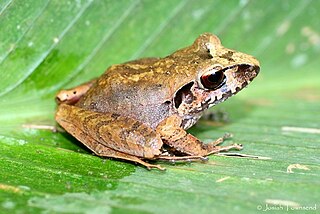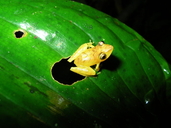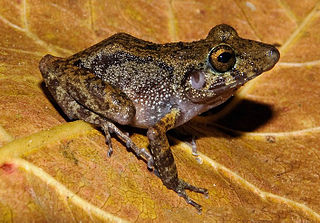Atelopus senex is an extinct species of toad in the family Bufonidae. It was endemic to Costa Rica and known from the Cordillera Central and Cordillera de Talamanca at elevations of 1,100–2,200 m (3,600–7,200 ft) asl.

Cochranella euknemos, sometimes known as the San Jose Cochran frog, is a species of frog in the family Centrolenidae. It is found in central Costa Rica and south/eastward to Panama and to the western flank of the Cordillera Occidental in Colombia. Some Colombian records might apply to Cochranella mache.
Silverstoneia nubicola is a species of frog in the family Dendrobatidae. It is found in western Colombia, Panama, and southwestern Costa Rica.

Agalychnis saltator is a species of frog in the family Phyllomedusidae. It is found in the Caribbean lowlands from north-eastern Honduras through Nicaragua to east-central Costa Rica at elevations of 15–1,300 m (49–4,265 ft) asl. Its common names are parachuting red-eyed leaf frog and misfit leaf frog.
Craugastor andi is a species of rain frog in the family Craugastoridae which has not been seen since 1990. It is found in the Caribbean drainage of Costa Rica in the mountains and hills of the Cordillera Central and the far northeastern Cordillera de Talamanca, and in extreme northwestern Panama. Frank and Ramus (1995) give it the vernacular name Atlantic robber frog. It is known locally in Spanish by the generic names, used for many species, of rana de hojarasca, ranita or sapito.

Strabomantis bufoniformis is a species of frog in the family Craugastoridae. It is found in western Colombia, Panama, and southeastern Costa Rica. It is sometimes known as the rusty robber frog.
Craugastor catalinae is a species of frogs in the family Craugastoridae. It is found in the Río Cotón drainage in the Pacific southwestern Costa Rica and on the Pacific slopes of Volcán Barú, western Panama. The specific name catalinae, rather obliquely, honors Karen R. Lips: Spanish name "Catalina" corresponds to Danish name "Karen". Lips collected a part of the type series and has "contributed substantially to our knowledge of the Río Cotón drainage herpetofauna and the declining amphibian populations problem in lower Central America."

Craugastor escoces is a species of frog in the family Craugastoridae. It is endemic to Costa Rica. After not having been seen after 1986—despite extensive directed surveys—it was declared extinct by the International Union for Conservation of Nature (IUCN) in 2004. However, the species was rediscovered in September 18, 2016, when two researchers from the University of Costa Rica found a female Craugastor escoces at the edge of the Juan Castro Blanco National Park in Alajuela Province.
Craugastor fleischmanni is a species of frog in the family Craugastoridae. It is endemic to Costa Rica where it has been found on the Meseta Central Oriental and Occidental, the Pacific slopes of the Barva and Poás Volcanos, the Atlantic slopes of the Irazú and Turrialba Volcanos, and on the Cordillera de Talamanca. Common name Fleischmann's robber frog has been suggested for this species.

Craugastor laticeps is a species of frog in the family Craugastoridae. It is found in Belize, Guatemala, Honduras, and southern Mexico.

Craugastor mimus is a species of frog in the family Craugastoridae. It is found in lowland and premontane forests on the Atlantic versant from eastern Honduras through eastern Nicaragua to central Costa Rica. Its natural habitat is lowland and premontane moist and wet forests. It is threatened by habitat loss.
Craugastor obesus is a species of frog in the family Craugastoridae. It is found in the Caribbean slopes of southeastern Costa Rica and western Panama. Its natural habitats are lowland moist forest, premontane and lower montane wet forest and rainforest. It can be found in the spray zone on rocks, boulders, and cliff faces in the middle of moderate-sized cascading streams.
Craugastor ranoides is a species of frog in the family Craugastoridae. It is found in the southern Atlantic lowland of Nicaragua and northwestern Costa Rica, and through Costa Rica to extreme western Panama. Its natural habitats are, principally, lowland and premontane wet forests in association with small streams, but also dry forests with perennial streams. It is threatened by habitat loss and chytridiomycosis. The species has disappeared from much of its former range in Costa Rica, also in pristine habitats, possibly because of chytridiomycosis.
Craugastor rayo, also known as the Sabana robber frog, is a species of frog in the family Craugastoridae. It is endemic to the Cordillera de Talamanca, Costa Rica.

Craugastor taurus is a species of frog in the family Craugastoridae. It is found in the Golfo Dulce region of southern Costa Rica and adjacent western Panama. It is sometimes known as the Golfito robber frog.
Pristimantis altae is a species of rain frog in the family Craugastoridae with a bright coral-coloured groin. It is found in Costa Rica and Panama. It is locally known as sapito de hojarasca. In 2008 the IUCN began calling it the mountain robber frog following Frank and Ramus (1995).

Pristimantis caryophyllaceus is a species of frog in the family Craugastoridae. It is found in Costa Rica and Panama; records from Colombia prior to 2010 refer to Pristimantis educatoris. However, taxonomy of Pristimantis caryophyllaceus and P. educatoris remain unsettled, and many sources continue to report Pristimantis caryophyllaceus from Colombia.

Pristimantis gaigei is a species of frog in the family Craugastoridae. It is found in the Atlantic drainage lowlands from extreme southeastern Costa Rica to eastern Panama and to central Colombia; it is widely distributed in Colombia west of the Cordillera Oriental. Its natural habitat is primary humid lowland forest, but it also occurs in secondary forest. It is a nocturnal species found under surface debris and in leaf-litter.
Ctenophryne aterrima is a species of frog in the family Microhylidae. It is found in northwestern Ecuador, the Andes of Colombia, and lowland and premontane zones of Panama and Costa Rica to about 1,600 m (5,200 ft) above sea level.

The Peralta frog, or montane leopard frog, Lithobates taylori, is a species of frog in the family Ranidae found in Costa Rica and Nicaragua.










